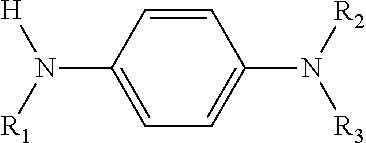Cross Products and Co-Oligomers of Phenylenediamines and Aromatic Amines as Antioxidants for Lubricants
a technology of aromatic amines and cross products, which is applied in the direction of additives, lubricant compositions, petroleum industry, etc., can solve the problems of less effective antioxidant mixtures of only homo-oligomers of parent amines
- Summary
- Abstract
- Description
- Claims
- Application Information
AI Technical Summary
Benefits of technology
Problems solved by technology
Method used
Image
Examples
example 1
[0116]To a 500 mL 14 / 20 three-neck flask equipped with a magnetic stir bar; a short-path condenser with nitrogen inlet, placed atop at Vigreux column; a thermocouple, and an addition funnel is charged 29.80 g (N-phenyl-N′-1,4-dimethylpentyl)-p-phenylenediamine, 40.90 g dodecyl-phenyl-α-naphthylamine, and 131.3 Hatcol® 1189 pentaerythritol ester lubricant. The addition funnel is charged with 44.0 g di-tert-butyl peroxide.
[0117]The mixture of amines and lubricant is heated to 144° C., and the peroxide is added over 5 h. Tert-butanol begins to distill once about half of the peroxide has been added. Once the addition is complete, the reaction temperature is increased to 173° C. over 1 h. The reaction is cooled, and the Vigreux column removed, attaching the short-path condenser directly to the reaction vessel. Volatiles are distilled under vacuum to an internal pot temperature of 173° C. at 0.15 ton. The reaction mixture is pressure filtered hot through a 1μ filter pad, yielding 195.6 g ...
example 2
[0118]Prepared according to general procedure of Example 1; using 32.26 g tert-octyl phenyl-α-naphthylamine, 32.77 g N-(1-methyldecyl)-N′-phenyl-p-phenylenediamine, and 120.77 g Hatcol® 1189 pentaerythritol ester lubricant. N-(1-methyldecyl-N′-phenyl-p-phenylenediamine), was prepared by reductive alkylation of N-phenyl-p-phenylenediamine with Eastman C-11 ketone, available from Eastman Chemical Company.
example 3
[0119]Prepared according to general procedure of Example 1, using 43.52 g tert-octyl phenyl-α-naphthylamine, 28.76 g N-N′-di-sec-butyl-p-phenylenediamine, and 120.77 g Hatcol® 1189 pentaerythritol ester lubricant. The vacuum strip removed 6.49 g unreacted N-N′-di-sec-butyl-p-phenylenediamine.
PUM
| Property | Measurement | Unit |
|---|---|---|
| temperature | aaaaa | aaaaa |
| temperature | aaaaa | aaaaa |
| temperature | aaaaa | aaaaa |
Abstract
Description
Claims
Application Information
 Login to View More
Login to View More - R&D
- Intellectual Property
- Life Sciences
- Materials
- Tech Scout
- Unparalleled Data Quality
- Higher Quality Content
- 60% Fewer Hallucinations
Browse by: Latest US Patents, China's latest patents, Technical Efficacy Thesaurus, Application Domain, Technology Topic, Popular Technical Reports.
© 2025 PatSnap. All rights reserved.Legal|Privacy policy|Modern Slavery Act Transparency Statement|Sitemap|About US| Contact US: help@patsnap.com



